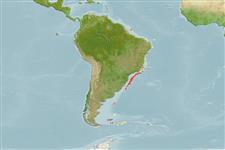Myxines (hagfishes) >
Myxiniformes (Hagfishes) >
Myxinidae (Hagfishes) > Eptatretinae
Etymology: Eptatretus: hepta (Gr.), seven; tretos (Gr.), perforated (i.e., with holes), referring to seven gill apertures on what would later be described as Homea banksii (=E. cirrhatus) [range within genus is 6-14 pairs of gill apertures]. (See ETYFish); menezesi: In honor of Naércio Aquino Menezes (b. 1937), Museu de Zoologia da Universidade de São Paulo, for his “extensive” contribution to Brazilian ichthyology. (See ETYFish).
Environment: milieu / climate zone / depth range / distribution range
Écologie
marin bathydémersal; non migrateur; profondeur 250 - 530 m (Ref. 36999). Deep-water
Southwest Atlantic: Brazil.
Taille / Poids / Âge
Maturity: Lm ? range ? - ? cm
Max length : 73.7 cm TL mâle / non sexé; (Ref. 36999)
Description synthétique
Clés d'identification | Morphologie | Morphométrie
A seven-gilled species of Eptatretus; a 3-cusp multicusp on both the anterior and posterior sets of cusps; total slime pores 86-94; tail slime pores 14-18; ventral finfold vestigial; body light brown and caudal finfold dark brown (Ref. 36999).
This species lives on the continental slope. It is a scavenger caught together with dead fish.
Life cycle and mating behavior
Maturities | Reproduction | Spawnings | Egg(s) | Fecundities | Larves
Copulatory organ absent. The gonads of hagfishes are situated in the peritoneal cavity. The ovary is found in the anterior portion of the gonad, and the testis is found in the posterior part. The animal becomes female if the cranial part of the gonad develops or male if the caudal part undergoes differentiation. If none develops, then the animal becomes sterile. If both anterior and posterior parts develop, then the animal becomes a functional hermaphrodite. However, hermaphroditism being characterised as functional needs to be validated by more reproduction studies (Ref. 51361 ).
Mincarone, M.M., 2000. Eptatretus menezesi, a new species of hagfish (Agnatha, Myxinidae) from Brazil. Bull. Mar. Sci. 67(2):815-819. (Ref. 36999)
Statut dans la liste rouge de l'IUCN (Ref. 130435)
Menace pour l'homme
Harmless
Utilisations par l'homme
Pêcheries: sans intérêt
Outils
Articles particuliers
Télécharger en XML
Sources Internet
Estimates based on models
Preferred temperature (Ref.
123201): 3.8 - 15.1, mean 10.6 °C (based on 15 cells).
Phylogenetic diversity index (Ref.
82804): PD
50 = 0.5000 [Uniqueness, from 0.5 = low to 2.0 = high].
Bayesian length-weight: a=0.00204 (0.00092 - 0.00452), b=2.93 (2.73 - 3.13), in cm total length, based on LWR estimates for this (Sub)family-body shape (Ref.
93245).
Niveau trophique (Ref.
69278): 4.3 ±0.7 se; based on size and trophs of closest relatives
Résilience (Ref.
120179): Faible, temps minimum de doublement de population : 4,5 à 14 années (Fec assumed to be <100).
Fishing Vulnerability (Ref.
59153): Moderate to high vulnerability (49 of 100).
